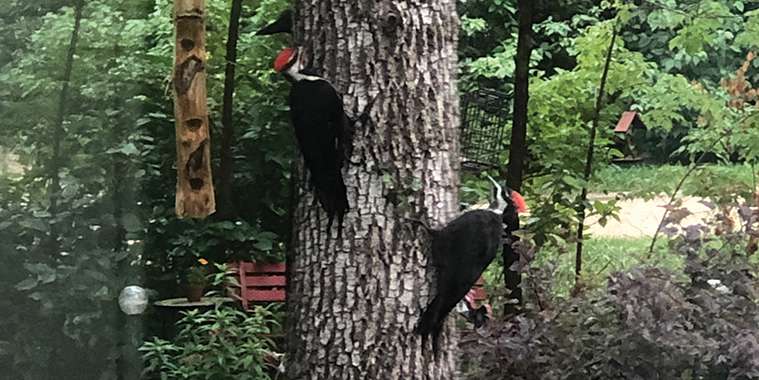No matter where you live in Manitoba, you’re going to see a woodpecker at some point. Most people are surprised by the fact that we have eight types of woodpeckers right here in Manitoba.
Downy Woodpeckers
Downy Woodpeckers are one of the most common woodpeckers here. They’re a fairly common sight in most backyards as they’ve adapted well to human development. These birds have a tiny bill and are small compared to other species. They have white bellies with a mostly black back that features streaks and spots of white. Male birds have a distinctive red spot on the back of their head, which females lack. These birds can hang upside down!
Hairy Woodpecker
The Hairy Woodpecker has been compared to soldiers, as they have cleanly striped heads and an erect posture while on trees. Their bodies are black and white overall with a long, chisel-like bill. Male birds can be identified by a red patch at the back of their heads, which females lack. They can be found anywhere where there are lots of large trees and are easily attracted to bird feeders. The Hairy and Downy woodpeckers are often confused because they look similar, but the Hairy woodpecker is larger and their bill is much longer. Also, a Hairy woodpecker’s tail feathers are completely white while the Downy’s are spotted.
Northern Flickers
Northern Flickers are very handsome birds and relatively common in Manitoba. They’re about the size of an American Robin and feature a black bib and spotted belly. There are two distinct variations of this bird, the Yellow-shafted and the Red-shafted. The Red-shafted is more common in the west. Look for a red mustache stripe, which is found on both sexes. In flight, you can clearly see red-orange feathers on their underwing and tail, as well as a mostly gray face with a brown crown. These birds don’t act like typical woodpeckers as they spend a lot of their time searching for insects on the ground by digging through dirt instead of drilling into trees.
Pileated Woodpecker
There is no other woodpecker quite like a Pileated Woodpecker. These birds are huge and adults can be up to 19 inches (48 cm) long and have a wingspan of 30 inches (99 cm) which is about the size of a crow. These birds are mostly black with white stripes on their face and neck. Look for a large triangular red crest on the top of their heads. Males have a red stripe on their cheek, while the stripe is black on females. These birds are commonly found in mature forests with lots of dead and fallen trees. They rely on rotting wood consisting of ants, wood-boring beetles, and termites to find food. Their drumming consists of 10-30 taps in less than a second and is used by both sexes to defend or establish territory, attract mates or to warn of intruders.
Yellow-bellied Sapsucker
Yellow-bellied Sapsuckers have a black and white backside and a large white shoulder patch. Look for their distinctive red crown and black and white striped face. As the name suggests, most individuals have a yellowish-white belly. The only way to tell males and females apart is by the colour of their throat — males have a red throat while females are white. This migratory woodpecker is usually found in young deciduous forests which are perfect for creating productive sap wells. Their favourite trees seem to be maples and birches. They rely heavily on tree sap as a high energy food and drill holes organized into rows in living trees. These holes become sap wells which then slowly leak sap.
Red-headed Woodpecker
Red-headed Woodpeckers are characterized by a large red head and a bill that is larger than most other species. Their back is entirely black, except for white wing patches, which contrasts against the pure white belly. In Canada, its range is primarily in southern Manitoba and southern Ontario. Unfortunately, populations of Red-headed Woodpeckers have declined by over 70% in the past 50 years and are considered endangered. The main culprit is habitat loss due to the destruction of beech forests due to a fungal disease called chestnut blight. and for aesthetic reasons, people cutting down dead trees which these woodpeckers rely upon for nesting cavities. These birds are one of only four woodpecker species known to store food. They will hide nuts, seeds, or insects under bark, in fence posts, or even wedged under roof shingles. Incredibly, they will even store living crickets by shoving them in a crevice so tightly they can’t escape!
American Three-toed Woodpecker
Both sexes have black and white barring around and across their bodies. Males have a yellow crown on the top of their head, whereas females have a black crown with white spots and streaks. You will find these woodpeckers living among conifer trees in disturbed areas that have been damaged by fires, wind storms or floods since these places have lots of dead trees and limbs which attract beetle larvae, a favourite of these woodpeckers. These birds have a distinctive foraging style. They chip at dead or dying trees until pieces of bark break off, which gives them access to the insects (and sometimes sap) beneath. One interesting fact about this bird is that it breeds farther north than any other woodpecker in Manitoba.
Black-backed Woodpecker
These woodpeckers are relatively easy to identify since, as the name suggests, they have a completely solid black back. Males have a distinctive yellow patch on the top of their head, which females lack. To spot one, all you have to do is find coniferous forests that have been recently burned as these birds feast on the wood-boring beetles that infest the dead trees. If the bounty is good, this woodpecker will stay in these areas anywhere from five to eight years after the initial burn.
Fun facts about the woodpecker
• They have super long tongues that are usually about twice the length of their bill so that they can reach for insects. When not in use, their tongue curls around the back of the head between the skull and the skin. They’re also made sticky by barbs or saliva.
• They’re designed to cling to trees with strong tail feathers that support the bird as it holds itself to a tree trunk, and they also have two back toes to lean back on.
• Their nostrils are fuzzy and covered in feathers to keep splinters and dust out while they peck.
• They don’t get headaches because their bills help distribute shock throughout the thick skull when pecking.
• In the animal world, woodpeckers are the only creatures to make a sound with something other than a part of its body. They’ll drum on a variety of objects to to communicate territory, attract mates, locate food, and maybe even to play.
• They like to stay upright. So when climbing down a tree, they lead with their tail first. Other insect-eating species of birds crawl down a tree head first.



